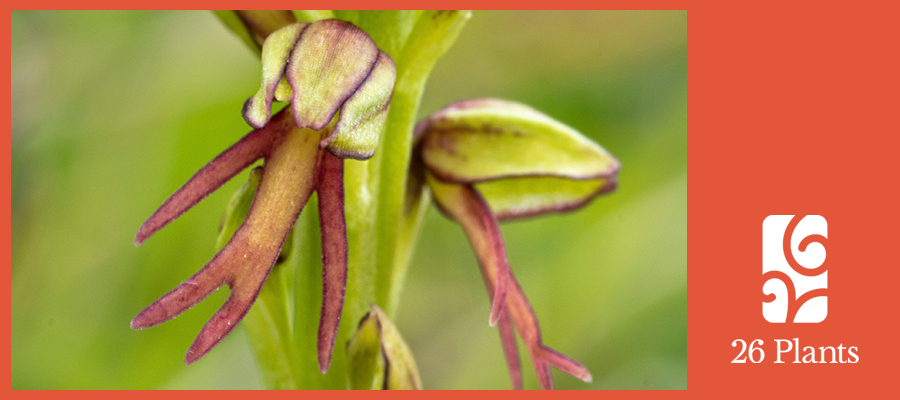Man Orchid
Orchis Anthropophora
Galen O’Hanlon

Let’s pollinate
Come, come lie in the grass with me,
Whispers the man orchid. Hear the sigh
Of the meadow at midday, the drowsy
Fizz of crickets, the air close, the sun high.
Lie with my pink-limbed men of the meadow,
Lovers of moths with long proboscides,
Longing for the touch of tongue at dusk, as the slow
Day gives way to a promiscuous breeze.
But here an uneasy silence grows
Between us: the loss of orchids, moths, and meadows.
Don’t go, don’t let that wingbeat be goodbye,
Savour this moment beneath the summer sky.
Stay awhile, let’s pollinate, come, come, lie.
Orchidelirium
There’s something deeply sexy about orchids, and we’ve always known it.
Confucius knew it, looking over a remote valley of orchids in full bloom, remarking on their beauty, fragrance and resilience in the harshest conditions.
The Greek philosopher Theophrastus knew it, though he lowered the tone, standing on a hillside above Athens, dusting the dry earth from the plant’s hairy tubers, feeling their weight in his hand, and naming them after the Ancient Greek for testicle, ὄρχις (órkhis).
The medieval Druids knew it, believing the man orchid’s roots could cure impotence.
The Victorians knew it, but they channelled the sexiness into a feverish desire to possess: orchidelirium. Wealthy collectors sent orchid hunters on dangerous, deadly and destructive expeditions to look for new varieties in the farthest reaches of the world.
And Darwin knew it. Studying orchids and their pollinators inspired all sorts of sexy thoughts about natural selection and co-adaptation. ‘‘I have found the study of orchids eminently useful,” he wrote to his friend Joseph Hooker, head botanist at Kew, “in showing me how nearly all parts of the flower are co-adapted for fertilisation by insects, & therefore the result of natural selection, — even the most trifling details of structure.”
Many orchids have evolved alongside a single insect pollinator, a lock and key relationship that drives elaborate specialisation. Some are masters of deception: the bee orchid has evolved to look and smell like a queen bee on heat. Male bees, utterly fooled, mate enthusiastically with the flower, covering themselves in the orchid’s pollen in the process.
But what of the man orchid itself? I’ve got lost in the lusty world of orchids and forgotten why I’m here. It’s vanishingly rare. It only grows in undisturbed chalk grasslands, a habitat we’ve mostly ruined in the UK. I found it in a strip of meadow on the west side of Biggin Hill, its pale green spikes shooting skywards from a fungal root-mound. In flower, it’s hung with a hundred little hooded men – hence the name. It’s priapic. It’s cute. And it’s unfussy about its pollinating partners: anything with a long-ish tongue will do, which helps in these endangered times. This promiscuity means it can happily cross-pollinate with the lady, monkey, or military orchid (sounds like quite a party). The offspring, unusually for hybrids, are also able to reproduce. Not just with each other, but with their parents. I wonder what Theophrastus would make of that.
Image: Photograph by Galen O’Hanlon
